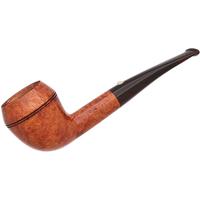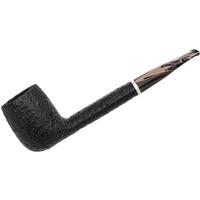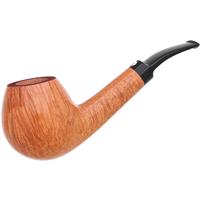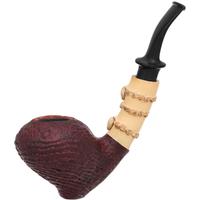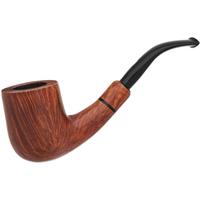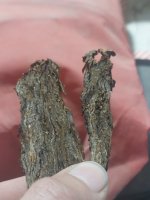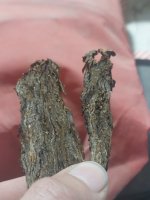Right on. I just called Sutliff and spoke to a dude named Andrew. He couldn’t tell so he’s forwarding the images to the production manager. I’m expecting a call from Andrew in the next few days and I’ll report back here when I do.I would call Sutliff Tobacco Company and ship this back for them to review. I would open another tin to also check. Please keep us posted.
Is This Mold? 2022 Cringle Flake
- Thread starter Auxsender
- Start date
You are using an out of date browser. It may not display this or other websites correctly.
You should upgrade or use an alternative browser.
You should upgrade or use an alternative browser.
Ok. Andrew called back and told me that due to this tobacco’s acidity, it reacted with the paper disc on top of the tobacco in the tin which left this residue. He said to wipe off and/or discard as much as I can and it will be fine to smoke. I dunno man, I don’t love it. Sutliff’s personalized and personable service was excellent but I’m not sure about smoking residue from a paper. I like my carcinogens unadulterated. 
Is it mold or not? Hard to tell but parts of it in the image look “webby”.
Some info on mold in processed tobacco.
If you see mold on the surface the tobacco the mycelia probably extend through much more of the tin unseen so you can’t reliably discard only the moldy parts. Also, microwaves are a type of non-ionizing radiation and only damage mold and spores by heating them to a high enough temperature for long enough. Long enough that the tobacco would likely be ruined. There’s also the possibility that the mold is a type that produces mycotoxins. If present these toxins are very unlikely to be denatured by a brief microwaving and modest temperatures.
Molds are everywhere and we have no practical way as hobbyists to identify the species on our tobacco and determine its risk to us. The most common mold on processed tobacco is Aspergillus Fumigatus. Over 30 other Aspergillus strains have been found in processed tobacco (Papavassiliou, et al, 1971). Some Aspergillus strains produce aflatoxins which can be fatal or produce long term damage when inhaled. If we don’t know what kind of mold we have we have no way to assess the risk.
A 1968 study done by scientists at the British American Tobacco Company (Wood, et al) determined that viable mold spores from contaminated tobacco enter the smoke stream in sufficient quantities to “...warrant some consideration of the role which micro-organisms may play with regard to smoke toxicity.” Theses studies were on cigarettes which are intentionally inhaled but we still unintentionally inhale some smoke even when smoking a pipe.
There are many who have reported brushing mold off of a blend and smoking it with no ill effects. Personally, I discard a moldy tin whether it smells or not. Life’s too short to smoke moldy tobacco. Tobacco is cheap and the risk, even if small, isn’t worth it to me.
We’re all adults and can make our own decisions but they should be informed decisions.
Some info on mold in processed tobacco.
If you see mold on the surface the tobacco the mycelia probably extend through much more of the tin unseen so you can’t reliably discard only the moldy parts. Also, microwaves are a type of non-ionizing radiation and only damage mold and spores by heating them to a high enough temperature for long enough. Long enough that the tobacco would likely be ruined. There’s also the possibility that the mold is a type that produces mycotoxins. If present these toxins are very unlikely to be denatured by a brief microwaving and modest temperatures.
Molds are everywhere and we have no practical way as hobbyists to identify the species on our tobacco and determine its risk to us. The most common mold on processed tobacco is Aspergillus Fumigatus. Over 30 other Aspergillus strains have been found in processed tobacco (Papavassiliou, et al, 1971). Some Aspergillus strains produce aflatoxins which can be fatal or produce long term damage when inhaled. If we don’t know what kind of mold we have we have no way to assess the risk.
A 1968 study done by scientists at the British American Tobacco Company (Wood, et al) determined that viable mold spores from contaminated tobacco enter the smoke stream in sufficient quantities to “...warrant some consideration of the role which micro-organisms may play with regard to smoke toxicity.” Theses studies were on cigarettes which are intentionally inhaled but we still unintentionally inhale some smoke even when smoking a pipe.
There are many who have reported brushing mold off of a blend and smoking it with no ill effects. Personally, I discard a moldy tin whether it smells or not. Life’s too short to smoke moldy tobacco. Tobacco is cheap and the risk, even if small, isn’t worth it to me.
We’re all adults and can make our own decisions but they should be informed decisions.
I say why take a chance? Some say it's mold, some say it ain't. Nobody really knows. As somebody else said, you only get one set of lungs. Compare less than $15 a tin to the cost of even the briefest of hospitalizations.......well, you get the point.
Sit on it for awhile. If it’s mold it’ll spread a lot quicker than anything else it’s doing. Wait and see where it goes.
I've said it before, and I'll say it again, use a loop!
You can tell in half a second if it's fuzzy mold or crystallin plume.
btw, that looks like plume to me, which is what the guy on the phone was trying to describe.
Mold would be everywhere, not just in the middle of some flakes.
You can tell in half a second if it's fuzzy mold or crystallin plume.
btw, that looks like plume to me, which is what the guy on the phone was trying to describe.
Mold would be everywhere, not just in the middle of some flakes.
^This. Doesn't look like mold to me but a little magnification puts the question to rest. Even a low power 10x loupe is enough to see if you've got a fuzzy fungal mycelium there.I've said it before, and I'll say it again, use a loop!
You can tell in half a second if it's fuzzy mold or crystallin plume.
btw, that looks like plume to me, which is what the guy on the phone was trying to describe.
Mold would be everywhere, not just in the middle of some flakes.



